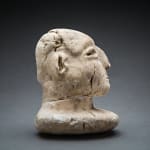Bactria-Margiana Idol, 2500 BCE - 1800 BCE
Stone
18 x 12 cm
7 1/8 x 4 3/4 in
7 1/8 x 4 3/4 in
SF.078
Further images
This is another piece which pertains to an ancient culture referred to both as the Bactria-Margiana Archaeological Complex (BCAM) or as the Oxus Civilisation, providing a hint to the religious...
This is another piece which pertains to an ancient culture referred to both as the Bactria-Margiana Archaeological Complex (BCAM) or as the Oxus Civilisation, providing a hint to the religious beliefs of the ancients who flourished there. The head itself is carved from stone, with a face dominated by hollowed large, almond-shaped eyes, a prominent nose, a gently smiling mouth, and protruding ears.
The Bactria-Margiana culture spread across an area encompassing the modern nations of Turkmenistan, Tajikistan, Uzbekistan and Northern Afghanistan. Flourishing between 2100 and 1700 BC, it was contemporary with the European Bronze Age and characterised by monumental architecture, social complexity and extremely distinctive cultural artefacts.
The significance of these Bactrian idols is unclear. Some scholars identify them as elite members of this early society, while others consider their compelling monumentality to signify that these female figures are depictions of one (or more) goddesses. Religion may then have been based around deities represented by pieces such as this, however, such pieces are extremely rare. A 2003 inventory calculated that there were at least thirty-eight examples of such Bactrian idols known, and although the number of examples discovered since has increased, the total number of such Bactrian idols remains relatively small. Nine examples have been found in south-eastern Turkmenistan and two more in Pakistan.
The Bactria-Margiana culture spread across an area encompassing the modern nations of Turkmenistan, Tajikistan, Uzbekistan and Northern Afghanistan. Flourishing between 2100 and 1700 BC, it was contemporary with the European Bronze Age and characterised by monumental architecture, social complexity and extremely distinctive cultural artefacts.
The significance of these Bactrian idols is unclear. Some scholars identify them as elite members of this early society, while others consider their compelling monumentality to signify that these female figures are depictions of one (or more) goddesses. Religion may then have been based around deities represented by pieces such as this, however, such pieces are extremely rare. A 2003 inventory calculated that there were at least thirty-eight examples of such Bactrian idols known, and although the number of examples discovered since has increased, the total number of such Bactrian idols remains relatively small. Nine examples have been found in south-eastern Turkmenistan and two more in Pakistan.







